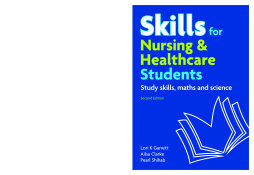
Additional Information
Book Details
Abstract
This clear, helpful and interactive book will help you prepare for and succeed in your nursing and healthcare studies. Supporting anatomy and physiology, drug administration, clinical practice and preparation for assessments, this book will give you the tools to success. Using examples from practice to bring the subjects to life, Skills for Nursing & Healthcare Students is your essential guide to the core skills you will need to master. The book includes guided explanations and interactive exercises that will help you brush up on your maths and study skills and get up-to-speed with anatomical terminology, the basics of the human body, chemistry and cell biology.
Table of Contents
| Section Title | Page | Action | Price |
|---|---|---|---|
| Cover | Cover | ||
| Skills for Nursing and Healthcare Students Study skills, maths and science | i | ||
| Brief contents | v | ||
| Contents | vii | ||
| Adaptors’ preface to Skills for Nursing and Healthcare Students | ix | ||
| Preface for students | xi | ||
| Preface for instructors | xv | ||
| Publisher’s acknowledgements | xix | ||
| Study skills The proper care and feeding of a human brain | 1 | ||
| Why should I study anatomy and physiology? | 3 | ||
| Learning styles | 4 | ||
| Getting ready | 11 | ||
| Lecture | 16 | ||
| Taking notes | 17 | ||
| In practical classes | 21 | ||
| Outside the classroom | 22 | ||
| The study group | 31 | ||
| How to read a textbook | 32 | ||
| The study environment | 35 | ||
| Time | 37 | ||
| The test | 41 | ||
| Individual accountability | 48 | ||
| Running words | 49 | ||
| What did you learn? | 50 | ||
| Web resources | 51 | ||
| Basic maths review Crunching the numbers | 53 | ||
| Maths in science | 54 | ||
| Basic maths operations | 55 | ||
| Mean | 58 | ||
| Fractions, decimals and percentages | 61 | ||
| Understanding exponents | 72 | ||
| Ratios and proportions | 74 | ||
| The metric system | 77 | ||
| Basic measurement | 82 | ||
| Tables, graphs and charts | 88 | ||
| Running words | 94 | ||
| What did you learn? | 95 | ||
| Web resources | 96 | ||
| Terminology You say humerus, I say funny bone | 99 | ||
| language | 100 | ||
| Types of terms | 104 | ||
| Building descriptive terms | 109 | ||
| Combining word roots | 116 | ||
| Anatomical position | 119 | ||
| Basic anatomical terminology | 122 | ||
| Running words | 132 | ||
| What did you learn? | 132 | ||
| Web resources | 135 | ||
| Body basics The hip bone’s connected to the . . . | 137 | ||
| The biological hierarchy of organisation | 138 | ||
| Basic biological rules | 142 | ||
| Tissue | 159 | ||
| The organ | 162 | ||
| The organ systems | 163 | ||
| Running words | 173 | ||
| What did you learn? | 174 | ||
| Web resources | 175 | ||
| Chemistry The science of stuff | 177 | ||
| Matter | 179 | ||
| Element | 181 | ||
| Atomic structure | 184 | ||
| Periodic table of elements | 190 | ||
| Chemical interactions | 194 | ||
| Chemical bonding | 196 | ||
| Electrolytes and pH | 209 | ||
| Inorganic compounds | 212 | ||
| Organic | 213 | ||
| Chemical reaction | 221 | ||
| Chemistry and energy | 224 | ||
| Running words | 225 | ||
| What did you learn? | 227 | ||
| Web resources | 229 | ||
| Cell biology Life’s little factories | 231 | ||
| Cell theory | 232 | ||
| Prokaryotes and eukaryotes | 237 | ||
| The cell membrane | 240 | ||
| Cell organelles | 245 | ||
| Movement processes | 255 | ||
| The cell cycle | 269 | ||
| Meiosis | 274 | ||
| Running words | 275 | ||
| What did you learn? | 276 | ||
| Web resources | 279 | ||
| Answer key | 281 | ||
| Index | 285 |
